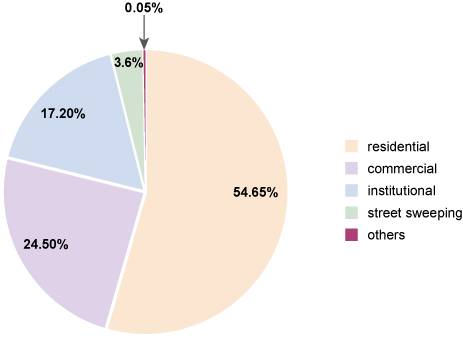7.1 Sources of solid waste in urban areas
Thinking back to Study Session 1, how would you define ‘solid waste’? Using your general knowledge and previous experience, list the types of solid waste generated in the area where you live or work.
Solid waste is anything that is not a liquid and which is thrown away because it is not wanted.
There are many possible answers to the second part of this question. You may have thought of wastes produced in domestic houses such as paper and plastic packaging, or peelings and other waste from food preparation. Other answers could include wastes from industry, commerce, schools, colleges and health facilities.
Solid wastes are all the wastes arising from human and animal activities that are normally solid and are discarded as useless or unwanted by the person or organisation that produces the waste.
You may recall from Study Session 1 that solid waste can be classified according to its source. The major sources of solid wastes in urban areas of Ethiopia are shown in Box 7.1.
Box 7.1 Major sources of solid wastes in urban areas of Ethiopia
- Residential sources: from households and residential areas. These are the major sources of solid waste in almost all cities and towns in Ethiopia.
- Commercialsources: from businesses such as food and drink establishments, shops, banks, etc.
- Institutionalsources: from public and government institutions e.g. offices, religious institutions, prisons, schools, universities, etc.
- Open areas: waste from street sweepings, roadside dustbins, ditches and other public places.
- Industrialsources: from various types of industrial processes.
- Health facilities: from hospitals and other health facilities.
- Construction and demolition: from various types of construction and demolition activities in urban areas such as the construction of apartments, the demolition of urban slums, etc.
- Agricultural sources: from farming — more common in peri-urban areas of small and medium towns of Ethiopia and in rural areas.
- Electronic and electrical waste (e-wastes):waste electronic devices (computers, phones, radios, etc.) and household appliances (cookers, washing machines, etc.).
Residential solid wastes (sometimes called household waste) usually form the largest proportion of municipal waste (the combined solid wastes in an urban area). Let us take Bahir Dar as an example. Bahir Dar is a city on the southern shore of Lake Tana, about 600 km north-west of Addis Ababa, with a population of 320,000. In 2010 a waste survey was undertaken as the first stage of a programme to find better ways of treating the city’s waste. Figure 7.1 shows the survey results for the proportion of waste from different sources. You can see that the majority of the solid waste (55%) comes from residential areas (Forum for Environment/UNEP, 2010). In Bahir Dar, the household waste is collected by a private contractor and taken to an open dump for disposal. (You will learn more about waste disposal sites in Study Session 10.)

Types of solid waste generated in residential areas includes food wastes, packaging (bottles and cans), papers and miscellaneous items that have been used up or broken and are thrown out as waste (e.g. ashes, old shoes, worn out clothes, broken cooking pots, paper, baskets, bags, etc.). You should also note that, in areas where latrines are not available, bags of human faeces may be found among the waste.
Plastics in the form of bags and bottles make up a relatively small proportion of residential waste, but these present a major problem. Plastics do not degrade (or degrade at a very slow rate), and so they tend to accumulate in the streets and in watercourses. Plastic bags can also choke farm animals and wildlife if they are ingested (Figure 7.2).

Learning Outcomes for Study Session 7
